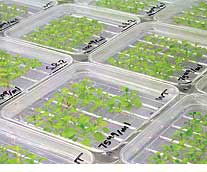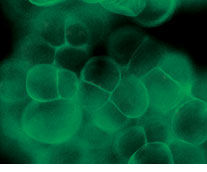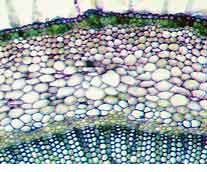


Sweet Dreams
by Kathleen Cason
Intro
| Charting the course
| The team's beginnings
| The pitch
Cross-country caravan
| The gathering
| Collaborations


Experimental Arabidopsis plants growing in culture.

The cell walls of tobacco cells, which glow green
due to a special stain, are made of six types of
complex carbohydrates.

The perimeter of each round cell in this cross-section
of a tobacco stem is composed of sugar-based compounds
that give plants structure, regulate growth and trigger
defense mechanisms.
Cross-country caravan
In September 1985, 16 members of their Colorado research group loaded up half a dozen huge moving
vans, cramming them with the contents of labs and homes. The caravan snaked across the plains and
deep South, heading for Athens, Ga.
But it wasn’t all smooth sailing in the beginning. Many UGA scientists had expected a piece of the
biotechnology pie from the Georgia legislature and they were clearly upset that the entire sum had
been earmarked for outsiders.
Plus the university — with no available laboratory space for the new center — had negotiated for
space in a federal laboratory, a decision that sparked tension. It became evident early on that the
CCRC needed its own facility.
Despite the early setbacks, researchers got busy and the grants started rolling in from such
sources as the U.S. Department of Energy, which had launched a nationwide request for research
proposals on complex carbohydrates.
“Only two proposals were worth going after: One from Harvard and one from the University of
Georgia,” said Robert Rabson, who directed the DOE’s Division of Energy Biosciences at that time.
“The Harvard proposal was strictly medical and we wanted to support a more broad approach so we
decided to fund the CCRC.”
By 1987, the CCRC had earned designation as a national resource center for studying complex
carbohydrates in plants and microbes. That brought with it steady DOE funding.
In 1989, the CCRC finally moved into its own home: a 45,000-square-foot facility. The center had
grown from 16 people to 80. And that year they also captured funding from the National Institutes
of Health to establish a second national resource center — this time for biomedical research.
From that moment on, the center continued to support research on plant carbohydrates but also began
to emphasize biomedical research. Two additions to the building reflected growth in the biomedical
area — one enlargement added a larger nuclear magnetic resonance (NMR) facility and a second one in
1998 doubled the facility’s size because the CCRC again had outgrown its home.

The CCRC has dominated research internationally
in two areas: studies of plant cell walls and
development of methods to unravel complex
carbohydrate structures. Recently the center
has undergone major expansion in biomedical
carbohydrate science.
Intro
| Charting the course
| The team's beginnings
| The pitch
Cross-country caravan
| The gathering
| Collaborations
For comments or for information please e-mail the editor: jbp@ovpr.uga.edu
To contact the webmaster please email: ovprweb@uga.edu
![]()